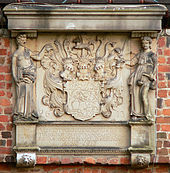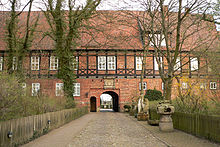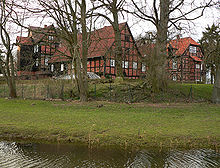Ahlden Castle
Ahlden Castle in Ahlden (Aller) in Lower Saxony was built as a moated castle on the Aller from 1549 . The three-wing palace is now privately owned and used as an art auction house.
By the banishment of Princess Sophie Dorothea of Brunswick-Lüneburg the castle end of the 17th century to the end of her life, it found its way into literature.
location
Opposite the castle, on the other bank of the river, was the Bunkenburg, which is now only in ruins . It is believed to have originated in the 13th century. It was built across from Ahlden on the banks of the Aller . In 1618 the Aller moved its river bed to the east when the water level was high, and from then on the water of the Leine flowed past Ahlden through a dam building upstream . Since 1648 the course of the river “Alte Leine” has been transformed into an oxbow lake that has been drained in places . The present castle was built in the 16th century on the river bank of Ahlden opposite the Bunkenburg. Today it is located on an old arm of the Aller, which led Leinewasser from 1618 and has been called "Alte Leine" ever since.
Building description
The castle is essentially a half-timbered building , only the ground floor of the west wing is made of brick . The building today consists of three two-storey wings in the shape of a horseshoe, which were built from 1549. In earlier centuries the complex was almost closed at times and had an inner courtyard. The individual wings of the building were not only used for living, they were also stables and coach houses .
The west wing is the main building of the palace, which Duke Christian the Elder of Braunschweig-Lüneburg had his Drosten Johann Behr built in 1613. At the entrance to the inner courtyard you can still see the recesses in the wall of the drawbridge . During the construction of the wing of the building, there was a serious accident in 1613 when the roof beams came loose and seriously injured 14 workers.
The south wing as a half-timbered building with brick filling is the oldest part of the building. It was completed in 1579 under Duke Wilhelm the Younger of Braunschweig-Lüneburg, as indicated by a bar inscription. The inner courtyard side of the building wing has an elaborately designed Renaissance facade.
The north wing is a half-timbered building that was redesigned in 1705 by the architect Johann Caspar Borchmann because it was dilapidated. Outside the castle there was a gatehouse with a passage. It was used to monitor access and was probably demolished around 1800. The building is clearly recognizable on the Merian engraving from 1654 as a building set apart from the castle.
Originally the castle was surrounded by a double moat and a wall. The wall was leveled in 1690 in order to set up a French pleasure garden . The trenches were filled in in the 19th century.
history


The predecessor facility Bunkenburg was built on the opposite bank of the Aller, which Merian also describes. This castle was owned by the von Ahlden family, first mentioned in the 13th century, who served as knights and castle men. The fortifications, which previously belonged to the diocese of Minden , are first mentioned in a document in 1433 . In 1431 there was a change of ownership of Ahlden and its castle. The Lords of Ahlden lost everything in the dispute with the diocese and the Guelphs . They had broken their promise to stop feuds and raids. In this way, Ahlden came into the possession of the Duke of Lüneburg. Between 1443 and 1575 the Ahlden property was pledged to the von Mandelsloh family. It was not until the 16th century that today's palace complex was built, while the Bunkenburg fell into disrepair.
The princely office of Ahlden was established as early as 1431 . It took over the administration and exercised the jurisdiction. The castle also belonged to the office. The facility was headed by a bailiff who collected taxes from the citizens and ran agriculture on the state's own farm, the Vorwerk near the castle. From 1784 the castle was redesigned for official purposes and also housed the prison. After around 450 years of existence, the Ahlden office was dissolved in 1884 and became part of the Fallingbostel district . After that, the castle housed the Ahlden District Court until 1972. Already since 1310 law was spoken in Ahlden.
During the Thirty Years War , the castle was occupied by imperial troops under Johann T'Serclaes von Tilly after a day of siege. They defended it against an unsuccessful attack by 800 Danish besiegers. From 1726 Schloss Ahlden was the official residence of the Landdrosten .
The palace building, in need of considerable renovation, was sold in 1975 for a price of 90,000 DM from state property. An art auction house acquired the castle as a representative company headquarters. It was required to keep the castle courtyard open to the public by the hour during the day. Interior visits are only possible to a limited extent as part of previews at auctions.
Exile
In 1694 the castle was a feudal prison for Princess Sophie Dorothea of Braunschweig-Lüneburg for 32 years . She stayed here until her death in 1726, which is why she was also called the "Princess of Ahlden" or "Duchess of Ahlden". First Sophie Dorothea was arrested here in 1694 after the Königsmarck affair , only to be spent at Lauenau Castle on Hanoverian soil, where the divorce process took place. After her conviction for infidelity, she was exiled to Ahlden Castle for life at the behest of her husband, Elector Georg Ludwig . She never saw her two children again, but later corresponded with her daughter, the Prussian Queen Sophie Dorothea , in the hope that she could effect her release.
The princess's husband, Elector Georg Ludwig, confiscated the assets she had brought into the marriage, but left her an annual maintenance. The princess initially received 8,000 thalers for herself and her court , later up to 28,000 thalers. She was quartered in the north wing of the castle, a two-story half-timbered building. A guard of 40 men was deployed for the princess, five to ten of whom guarded the castle around the clock. The princess's contacts and her mail were strictly controlled. But there has never been an attempt at liberation or escape. Initially, the prisoner was only allowed to stay inside the castle, later also in the outside facilities when accompanied. After two years in prison, she was also allowed to drive about two kilometers in a carriage, stipulating exactly where to turn back. Drost zu Ahlden and commander of the guard was August Heinrich von Wackerbarth (1651–1711), whose wife Susanna von Berlichingen acted as first lady in waiting until his death .
The period of imprisonment in Ahlden was interrupted several times by war events or renovation work, whereby she was then housed in Schloss Celle or in Essel . After the devastating local fire of Ahlden in 1715, the princess contributed considerable sums of money to the reconstruction. She was allowed to receive visitors in the castle, for example from musicians. Her mother had unlimited visits. The court included two ladies-in-waiting, several chambermaids and other household and kitchen staff. The princess's lack of exercise led to her being very full. In early 1726 she suffered a stroke and died in November of the same year. An autopsy revealed a diseased liver and 60 gallstones. The princess found her final resting place in the family crypt in Celle.
Literary setting
The palace found its way into German literature with Theodor Fontane through Sophie Dorothea and in 1954 with Arno Schmidt through his novel Das steinerne Herz . The story was filmed in 1948 under the title Königsliebe with Joan Greenwood as Sophie Dorothea and Stewart Granger in the role of Count Königsmarck.
literature
- Rainer Hendricks: History of the area Ahlden on the Aller. Flecken Walsrode, Ahlden 2006, ISBN 3-00-019428-2 .
- Castles in the river. Castle landscape of the Aller-Leine-Valley. A project of the district of Soltau-Fallingborstel in cooperation with the Archäologische Arbeitsgemeinschaft eV and the Lower Saxony State Office for Monument Preservation. District of Soltau-Fallingbostel, Bad Fallingbostel 2005, ISBN 3-00-017281-5 .
- Ernst Andreas Friedrich : Celle Castle and Ahlden Castle. In: Ernst Andreas Friedrich: If stones could talk. From the history of Lower Saxony. Volume 1. Landbuch-Verlag, Hanover 1989, ISBN 3-7842-0397-3 , pp. 200-203.
Web links
- Entry by Stefan Eismann about Schloss Ahlden in the scientific database " EBIDAT " of the European Castle Institute
- Reconstruction drawing of the 16th century castle with rampart and moat
- Photos from Ahlden Castle at the Photo Archive Photo Marburg
Individual evidence
Coordinates: 52 ° 45 ′ 32.9 " N , 9 ° 33 ′ 28.3" E




